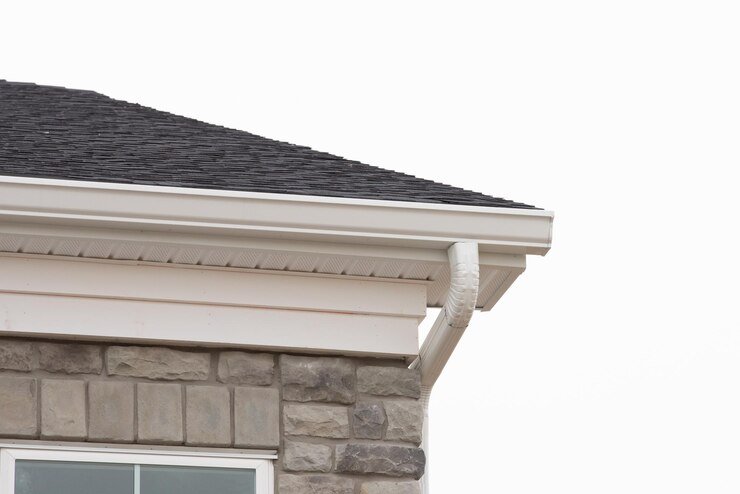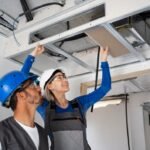If you are an owner of a home, you might have heard of the term “fascia roof” during maintenance or renovation. You may also be dealing with things like roof leaks, water damage, or unsightly mold, and an expert has advised that you check the fascia. However, what is a fascia roof exactly, and what makes it so important for your home? Now, let’s get straight to it and provide an answer to this most urgent question.
A fascia roof is a board mounted horizontally along the roof’s edge that forms from the point where the roof meets the outer wall of a house. This board, which is called the fascia board, is the most important in protecting the house from water damage. It is able to keep the roof system proper by the gutter and as a consequence, moisture does not get inside the roof structure. So, you have the basis now, so let’s move further in understanding the fascia roof, its functions, materials, and the benefits of increasing the life of your building.
What is a Fascia Roof?
A horizontal piece of material that runs along the lower edge of the roof, which is fixed to end trusses or rafters and supports eavestroughs. Normally, fascia boards hold the gutters and shield roofing borders against components from outside to flow water according to wildlife and waste.
While homeowners may not give the fascia board much thought because it is often overlooked behind other roofing components; as a key component of your roofline structure, ensuring that the starter course can be adequately supported above and below secures for a proper edge overlap on all sides. Fascia Failure: Because the fascia protects your home from moisture intrusion, an improperly functioning one can quickly and easily lead to water damage, rotting wood, or other failures of guttering.
Importance of Fascia Boards
1. Maintains Roof and Home Structure
Essentially, the fascia board prevents your home from coming into direct contact with outdoor weather mainly rainwater. As rain flows from the roof, gutters collect it and are held into place by fascia. Water can then be allowed to run in under the eave and the water damage ensues from is detrimental too as it will cause leaks, rot, and ruin of your rafters and whole roof structure without solid fascia boards.
2. Supports the Gutters
One of the important components that hold your gutter system in place, is the Fascia board. This is because gutters hold water running down your roof, and if the fascia board that they are attached to becomes weak or damaged in any way then you have sagging/broken gutters which will not be great for directing water away from your house. This additional damage to the roof will make it harder for gutters to direct rainwater away from your house.
3. Prevents Pest Intrusion
Fascia board works as a protective barrier for many pests including insects, birds, and rodents. Pests will get into your attic or roof space if the soffits and facia are cracked, broken, warped, or missing leading to possible pest infestations and additional damages to your home structure.
4. Improves Curb Appeal
A seamlessly installed and well-maintained fascia board adds to the charm of your abode. This provides you with an unobtrusive line to wrap about your roof edge, resulting in a noticeable change to the exterior of your residence. One simple way for homeowners to improve the facades of their homes is by either upgrading or maintaining the fascia.
Types of Fascia Materials
When choosing a fascia board, it’s essential to select the right material. The durability, appearance, and cost of the fascia depend on the type of material used. Here are the most common materials for fascia boards:
1. Wood
Wood fascia is the standard and still most employed. They are usually made from cedar or pine because of these types of resistance to moisture. Wood fascia boards are inexpensive and readily available, but need to be primed, painted, or stained on a regular basis in order to prevent rot.
2. Vinyl
Vinyl fascia boards require little to no maintenance and are weather, moisture, and insect-resistant. No painting is required and comes in various colors. But vinyl fascia can crack in the extremely cold, and repairs on it are a bit harder to perform than wood.
3. Aluminum
Highly durable, Maintenance Free Aluminium fascia boards. These are rust-proof, pest-free, and can stand against the harshest weather conditions. Aluminum fascia is a top choice among homeowners who want durable, low-maintenance alternatives. The downside is aluminum comes at a cost higher than wood or vinyl.
4. Composite
Composite fascia boards are many programs of wooden fibers mixed with plastic. The appearance is natural — like wood — with the durability of plastic. The decking is weather and insect-proof, meaning it is a low-maintenance solution. But they may be pricey compared to substances.
5. Fiber Cement
Why Use Fiber Cement Fascia Boards Strong durable and weather, fire, and pest resistant structures. They need lower repair than wood and offer a glance-old style. It also stands the test of time much better than wood or vinyl, however, those benefits come with a downside… fiber cement is heavy and harder to work with which can increase installation costs.
Indicators That Entail The Fascia Boards Need Replacing
Identifying the time to replace your fascia board can save you from big problems after some years. Some clear indicators that you should consider replacing your fascia board include:
1. Peeling or Cracked Paint
Peeling or Cracking Paint If the paint on your fascia board begins to peel, it has suffered water damage and may be rotting. If you can keep the paint or sealant on your fascia board in check, great — that only extends its life so much longer after all; but if any wood is exposed to some moisture.
2. Water Leaks Around the Roofline
If water is leaking over the edge of your roof, especially when it is raining or causing snow to melt into slushy, heavy runoff onto an already icy sidewalk and freezing there because you don’t opt for melting products like salt during such hard winters than this might be a very good indication that something has gone wrong with your fascia. This can lead to serious water damage of your roof structure.
3. Visible Rot or Mold
Visible water damage, rotting wood or mold on the fascia As the wood decays, it loses its ability to support your gutters and could result in further moisture getting inside of your home.
4. Gutter Sagging or Separation
It means that the fascia board is deteriorating and can no longer provide support for the gutter system effectively, leading to sagging of gutters, separation from the roofline, or pulling away from fascia A fascia replacement can save you from additional damage to your gutters and avoid water issues in the future.
How to Install a Fascia Board
This is a time-consuming and hands-on job to do properly however, if you have some tools in your shed it can be done. If you are repairing a damaged fascia board or installing one for the first time in a new home, these steps can help.
Step 1: Tear Off The Old Fascia Board
First, remove the existing fascia board carefully. If the board is rotten or cracked then it will come off very easily. Take out all the nails and screws before removing the board, make sure it’s not dirty.
Step 2: Take the Measurements of the New Fascia Board
This is the length of the roof edge where you will be replacing the fascia board. If necessary, shorten the fascia board exactly to size and fit it so that there is no clearance at all along the eaves.
Step 3: INSTALL THE FASCIA BOARD
Place the new fascia board next to the roof edge and attach it with galvanized nails or screws. The plank has to be horizontal and flat since this will impact the orientation of the gutters.
Step 4: Seal and Paint the Fascia Board
After the fascia board has been installed, apply caulking or paint to weatherproof it against moisture and UV damage. Bare with us, for the love of all that is holy!) Choose a paint or sealant color/finish just like you would Kiltz your basement… only also matching and complementing the overall exterior design.
Step 5: Attach the Gutters
Next, Waddell said to remount the gutters back onto that new fascia board and secure them properly so they are correctly positioned to move water away from your roofline as well as the foundation.
Roof Fascia Maintenance Tips
So you want to get some great fascia but more importantly, keep it from falling off your roof right? Follow these tips for the maintenance and protection of your investment in years to come!
- Regular Inspection: Check the fascia board at least yearly for damage, rot, or pest infestation. If you find a problem, correct it right away before it does further damage.
- Keep Gutters Clean: Speaking of leaks, gutter overflow is one of those problems you want to avoid since water sitting around can compromise the gutters as well as your fascia board. Keep Gutters Clean
- Repaint or Seal: If your property has wooden fascia boards, consider repainting them to ensure they are protected from moisture and UV damage.
- Trim Overhanging Branches: A storm can sometimes cause trees to lose branches that drop onto your house and harm the fascia board. Keep these trimmed, so as to not hit the edge of your roof.
- Repair Damaged Fascia Promptly: If you find that the fascia needs patching because of cracks, holes or rotting areas have a general contractor do it quickly to avoid further structural damage.
Conclusion
Every homeowner needs to know about what a fascia roof is and how it works. The fascia board isn’t merely there to look nice, it’s important for keeping your home safe from water and pest destruction—plus it supports the gutters! Keeping your fascia in good shape if you have it, or considering an upgrade to new materials can add years of life to that roof over your head while adorning the outside walls with materials resulting in further curb appeal.







